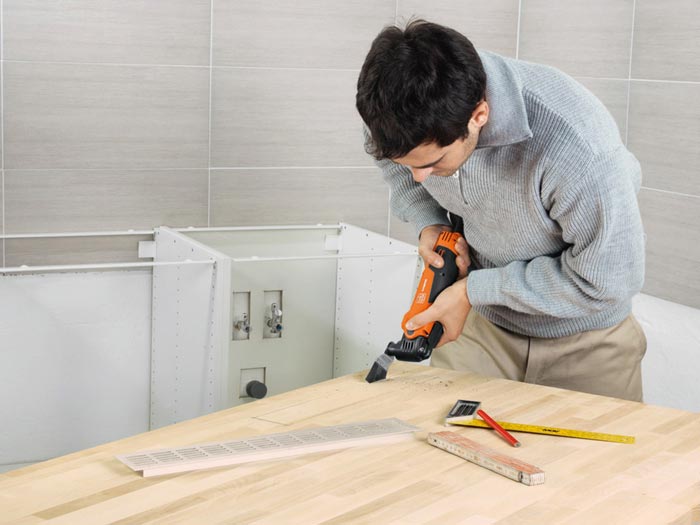Low-vibration sawing and sanding

FEIN’s versatile power tool vibrates up to 70 percent less and is only half as loud as its predecessor. © C. & E. Fein GmbH
If you’ve spent extended periods of time working with a drill or some other handheld power tool, you’ll know how quickly you’re longing to give your poor arms a rest. No wonder, either – such devices tend to vibrate a lot and be very loud. In the future, you’ll experience far lower vibrations when you want to drill, saw or sand something.
Researchers from the Fraunhofer Institute for Structural Durability and System Reliability LBF in Darmstadt teamed up with their colleagues at C. & E. Fein GmbH to develop a technology to dramatically reduce vibrations. “We examined how the system is set up and refined it so it can be applied to a range of handheld power tools,” explains Heiko Atzrodt, group manager at Fraunhofer LBF.
And this is precisely what FEIN has done to one of its oscillating power tools – in other words, a tool that doesn’t have a rotating action, but rather one that moves back and forth almost 19,500 times a minute. These and similar tools can do more than saw and sand; they are just as adept at rasping, polishing, shaving, cutting, severing, sharpening and filing – including at those hard-to-reach places.
Decoupling the housing from the motor
So how did the researchers manage to dramatically reduce how much handheld power tools vibrate? “Elastomer elements are used to decouple the housing from the motor and act like a form of mechanical suspension and insulation,” says Atzrodt. What this means is that only a tiny portion of motor vibrations are transferred to the housing and so to the user. You can, however, have too much of a good thing:
If the researchers were to insulate the housing too much, users would be unable to feel how hard they were pressing the tool onto whatever material they’re working with. So the researchers had to strike a balance between reducing vibrations and allowing users to retain a feel for what the tool is doing. This comes down to adjusting the stiffness of the elastomer elements.
First, the researchers used a simulation to determine the ideal stiffness range before integrating various suspension and insulation devices into a test system. This in turn allowed them to set the basic development parameters.
Up to 70 percent lower vibrations, 50 percent less noise
“By applying the anti-vibration system, FEIN was able to reduce vibrations by up to 70 percent compared to previous models,” says Atzrodt. “For almost all applications, the oscillator now belongs squarely in the zero vibration class.” Since this makes it permissible to work with this tool for up to eight hours at a time, technicians or autoworkers can now use it throughout their shift. The tool is also easier on the ears: Thanks to the new insulation, it now produces 50 percent less acoustic pressure.
This low-vibration oscillator is now on the market under the name FEIN MultiMaster FMM 350 Q. At Hannover Messe, the Fraunhofer LBF researchers will be offering visitors the chance to feel the difference for themselves by demonstrating the new-and-improved oscillator next to its predecessor.
http://www.fraunhofer.de/en/press/research-news/2015/March/low-vibration-sawing-…
Media Contact
All latest news from the category: Trade Fair News
Newest articles

Webb captures top of iconic horsehead nebula in unprecedented detail
NASA’s James Webb Space Telescope has captured the sharpest infrared images to date of a zoomed-in portion of one of the most distinctive objects in our skies, the Horsehead Nebula….

Cost-effective, high-capacity, and cyclable lithium-ion battery cathodes
Charge-recharge cycling of lithium-superrich iron oxide, a cost-effective and high-capacity cathode for new-generation lithium-ion batteries, can be greatly improved by doping with readily available mineral elements. The energy capacity and…

Novel genetic plant regeneration approach
…without the application of phytohormones. Researchers develop a novel plant regeneration approach by modulating the expression of genes that control plant cell differentiation. For ages now, plants have been the…





















